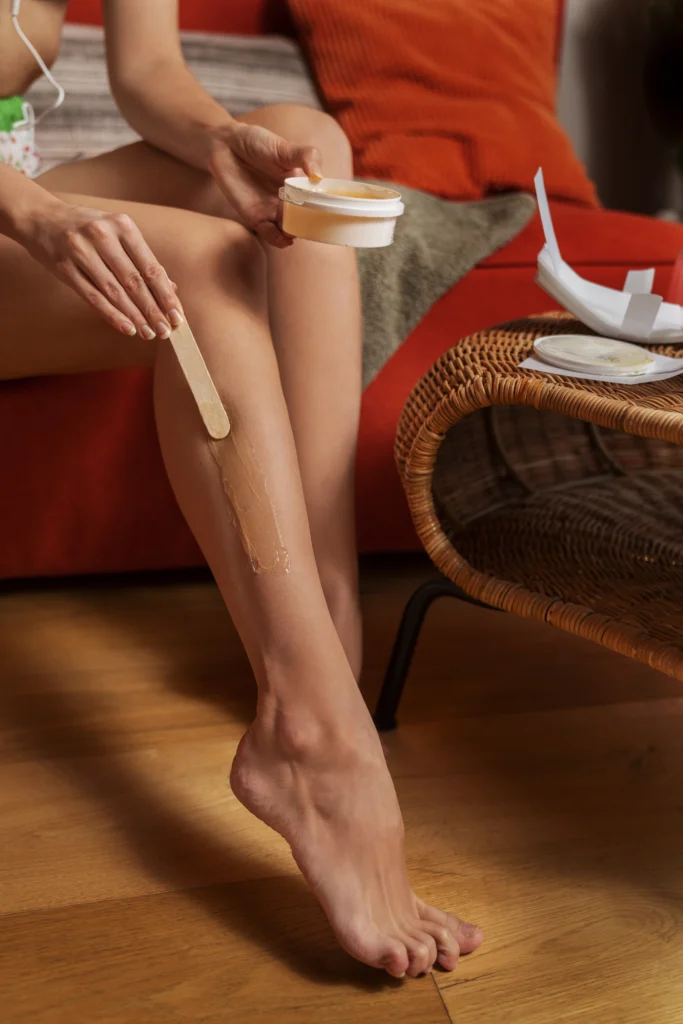Although the best we can do is plan our waxing schedule, sometimes it is not possible. Or for the last minute plan, or because the work does not allow it … That’s why we bring you some little tips that can help you when you need a last-minute hair removal done by yourself.
There’s nothing quite like the feeling of smooth, hair-free legs. While there are various hair removal methods available, waxing has long been a popular choice for achieving longer-lasting results. While many people turn to salons or spas for professional waxing services (services that you can book with us if you live in Surrey & London), you can also achieve salon-worthy results in the comfort of your own home. In this blog post, we will walk you through the process of waxing your legs at home, providing you with the necessary steps, tips, and precautions for a successful waxing experience.
Use this guide when waxing your legs at home:
1. Make sure your hair is long enough. Ideally, hair should be at least ¼ inch long before it can be waxed. The wax needs something to stick to, so anything shorter than ¼ inch could make the waxing experience uncomfortable and ineffective.
2. Gather Your Supplies: Before you begin waxing your legs at home, it’s essential to gather all the necessary supplies. Here’s a list of items you’ll need:
- Waxing kit (hot wax, pre-made wax strips, or sugar wax)
- Wax warmer or microwave-safe container (if using hot wax)
- Spatula or applicator sticks
- Baby powder or talcum powder
- Cleanser or pre-waxing oil
- Wax remover or baby oil
- Exfoliating scrub
- Moisturizer

3. Prep the skin with baby powder: Properly preparing your legs before waxing is crucial for optimal results and minimizing discomfort.
- Trim your leg hair to a suitable length (around ¼ inch) if it’s too long.
- Exfoliate your legs a day or two before waxing to remove dead skin cells and prevent ingrown hairs.
- Cleanse your legs with a gentle cleanser or pre-waxing oil to remove any oils, lotions, or dirt that may interfere with the wax’s adhesion.
- Apply a small amount of baby powder onto your legs to soak up any oils or moisture on the skin’s surface. You require your skin to be free of any type of product like lotions and creams, as well as any sweat or moisture.
4. Choose the Right Waxing Method: There are different waxing methods available for home use. Here’s an overview of the options:
- Hot Wax: Ideal for coarse hair, hot wax is melted and applied to the skin using a spatula. It hardens as it cools and is then removed by gripping the edge and pulling it off against the direction of hair growth.
- Pre-Made Wax Strips: These strips come pre-coated with wax and are ready to use. Simply warm them between your hands, apply to the skin, and remove in one quick motion.
- Sugar Wax: A natural alternative to traditional wax, sugar wax consists of sugar, lemon juice, and water. It is heated, applied to the skin, and removed using cloth strips or by flicking it off with your fingers.
5. Waxing Technique: Regardless of the waxing method you choose, here are some general tips for effective leg waxing:
- Apply the wax in the direction of hair growth and remove it against the direction of growth for optimal results.
- Work in small sections. Take your time to spread the wax in small sections along each leg and remove the hair using the strips in the direction of hair growth.
- Hold the skin taut with one hand while removing the wax with the other to minimize discomfort.
- Don’t pull straight up. This is a common rookie mistake and causes much more discomfort than necessary. Keep the waxing strip as close to the skin as possible and pull it at a slight angle. Remove the strip quickly for a smooth finish.
- Soothe the area. If you’re especially sensitive to waxing and feel a stinging sensation when the strip comes off, just apply some pressure with your hands on the area right after removing the strip. This will help to soothe the area and reduce inflammation. You can also use a skin-soothing lotion or cream that contains aloe or chamomile.
- Take breaks if needed, especially if you’re a beginner, as waxing larger areas can be time-consuming and physically demanding.
6. Aftercare and Maintenance: Once you’ve successfully waxed your legs, it’s essential to follow proper aftercare to soothe the skin and maintain the results. Here’s what you should do:
- Remove any residue or excess wax using a wax remover or baby oil.
- Apply a soothing post-waxing lotion or aloe vera gel to calm the skin and reduce redness.
- Avoid exposing your legs to direct sunlight, hot water, or excessive sweating for at least 24 hours to prevent irritation.
- Exfoliate your legs regularly to prevent ingrown hairs and maintain smoothness.
Waxing Your legs at home : Conclusion
Waxing your legs at home can be a convenient and cost-effective way to achieve beautifully smooth and hair-free skin. By following the steps and tips provided in this comprehensive guide, you can confidently embark on your at-home waxing journey. Remember to gather all the necessary supplies, properly prepare your legs, choose the right waxing method, and follow the appropriate techniques for optimal results. Additionally, don’t forget to take care of your skin post-waxing by using soothing products and maintaining a regular exfoliation routine. With practice and patience, you’ll be able to master the art of at-home leg waxing, enjoying the benefits of silky, hair-free legs whenever you desire. So go ahead and embrace the feeling of confidence and smoothness that comes with waxing your legs at home!
